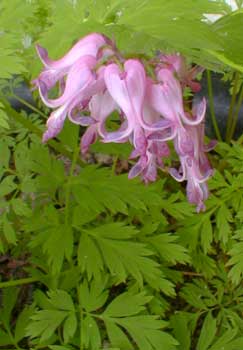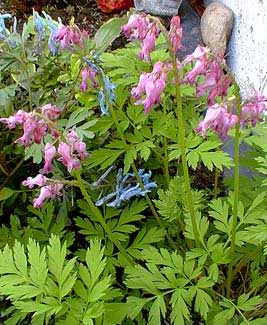
Pink Fringed
Bleeding Hearts
"Auntie Hannah, who had got on to the parsnip wine, sang a song about Bleeding Hearts and Death, & then another in which she said her heart was like a Bird's Nest; & then everybody laughed again; & then I went to bed."
-A Child's Christmas in Wales
Dylan Thomas
Dylan Thomas
Dicentra eximia or Fringed Bleeding Heart, aka Wild Bleeding Heart, or Eastern Bleeding Heart, blooms spring through autumn. In our garden it is as beautiful in September as it is in April, with even a few flowers lingering in October. For lasting-power of its lady-locket flowers, it is an essential perennial for temperate gardens.
It is shown in the first photo in a April (2004) portrait.The second photo in May (2003) captures also a few flowers intruding from the nearby Corydalis flexuosa. The ferny leafage grows a foot to 15 inches high.
"Pink" is essentially the species form, a wildflower native to eastern North America, found throughout the Appalachians from New England to Georgia.
It is not quite as showy as the Western Bleeding Heart (D. formosa) because the blooms are more slender & sometimes less numerous. But both are everflowering.
This & other Dicentra & Corydalis species are sometimes regionally known as "Turkey Corn" or "Squirrel Corn" because the rootstocks originate from a yellow bulb suggestive of a corn kernel. It is elsetimes called "Staggerweed" because like a few other Dicentra species also called staggerweeds, Pink Bleeding Heart has been known to have an intoxicating effect on cattle who browse on this cousin to the opium poppy.
 As a wildflower it is threatened or endangered over large portions of its natural range, as it does not appreciate the disruptions of encroaching civilization. But as cultivated for gardens it has been brought into temperate gardens world-wide.
As a wildflower it is threatened or endangered over large portions of its natural range, as it does not appreciate the disruptions of encroaching civilization. But as cultivated for gardens it has been brought into temperate gardens world-wide.It loves best a shady location. I have, however, seen these growing elsewhere in considerable sunlight, just so long as the ground doesn't become too dry. In much colder places than ours, it would generally prefer more sunlight. In a shady location, a well-established clump actually does become somewhat drought-tolerant.
In fact, its area should not get too much water at the height of winter, or the scaly rootstock may rot. Our "Pink" is planted against the wall way back under the eaves, because more drought-tolerant than the corydalises planted forward in the same garden where rain can reach those. We do have to water this area very well in summer, but we water almost nothing in winter because rainfall is sufficient, & during that time the Eastern Bleeding Hearts have the comparative dryness they require during dormancy.
The red heartshaped fringed flowers are strongest in spring & early summer. Many Dicentra species, especially the spectacular & large D. spectabilis (as well as several closely related Corydalis species), become dormant in summer, partially to completely dying to the ground, sometimes returning for a second burst of leaf & flower in the Autumn before dying back again for winter. But Fringed Bleeding Heart does not undergo this warm-weather die-back, just so long as it does not experience complete dryness during the warmest weeks. Kept moist in a protected location it will bloom & rebloom throughout the summer & right up to October.
It does die to the ground very late in Autumn or at the start of winter (in our mild zone it is visible as late as December). The rootstock is hardy to minus 40 degrees while it awaits the return of spring. It will not remain gone for long, as there is new growth before winter's end, at least for the Pink, which is showing its ferny leaves again in March, & once again in full flower by early April. Self-seeding can be expected, besides spreading rhizomitously.
We have a more delicate-looking white cultivar, D. eximia var alba which is slower to return after its winter rest, reappearing as leaves in April & not going gung-ho with flowers until May.